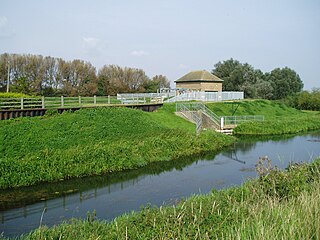River Glen, Lincolnshire
| River Glen | |
|---|---|

The pumping station at Tongue End, which marks the head of navigation, and the point at which the Bourne Eau joins the River Glen.
|
|
| Country | England |
| Basin features | |
| Main source | Ropsley and Boothby Pagnall |
| River mouth | River Welland, below Spalding |
The River Glen is a river in Lincolnshire, England with a short stretch passing through Rutland near Essendine.
The river's name appears to derive from a Brythonic Celtic language but there is a strong early English connection.
In the language of the Ancient Britons, which survives today as Welsh, Cornish and Breton, the neighbouring rivers, the Glen and the Welland seem to have been given contrasting names. The Welland flowed from the area underlain by the Northampton Sands which in many places are bound together by iron oxide to form ironstone. In the Roman period, the sands were easily worked as arable land and the ironstone was dug for smelting. In both cases, the ground was exposed to erosion which meant that silt was carried down to The Fens by the river. In modern Welsh, gwaelod (from Late Proto-British *Woelǫd-) means bottom and its plural, gwaelodion means sediment. Among the medieval forms of the name 'Welland' is Weolod; the river could have thus been named from its silty nature. In contrast, the Glen flowed from clays and limestone. Areas with clay-based soils tended to remain as woodland whilst the limestone areas provided grassland for pasture. Consequently, the River Glen did not carry much sediment. The modern Welsh for clean is glân. The relative amounts of silt deposited in the fens around Maxey and around Thurlby respectively, by the two rivers, support this view.
...
Wikipedia
